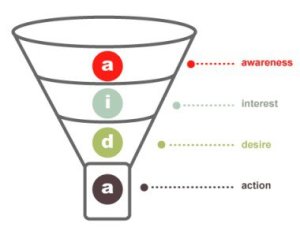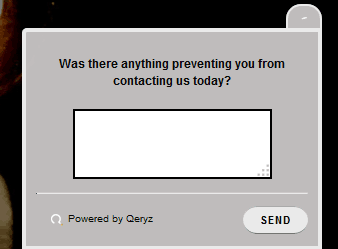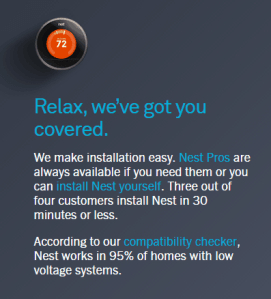Conversion optimization can increase your sales quickly and cheaply. Don’t go out and buy more traffic or put more time and effort into creating content. Instead, maximize your potential by using your existing website traffic to increase your conversion rate.
Even if you’re only getting a 2% conversion rate right now and you increase it to 3%, it’s a 50% increase in results!
If you can double your conversion rate, then you can afford to spend twice as much per click. And that means you can buy more traffic than your competitors, which means you gain more market share.
Sometimes just a small tweak based on a solid hypothesis can lead to significant improvements with your conversion rate. Think about this: even if you only increase your conversion rate by 5% each month, it will result in a 79.5% increase for the whole year.
1. Survey Your Site Visitors to Uncover User Intent and Areas of Friction
**Update: since this writing, I now recommend using Hotjar for site surveys and other analytcis.
When it comes to conversion optimization, there are things you know about your target customer and things you don’t. And since you can’t optimize for what you don’t yet know about your target customer, you have to reach out and ask them.
This is called qualitative research.
Set up a simple microsurvey on your website using Qeryz.
Qeryz is a newcomer to the microsurvey market and are taking on incumbents like Qualaroo Webengage. However, unlike the aforementioned survey tools, Qeryz won’t cost you anything to get started. And I’m not speaking of a trial period. It really is free. There is also a WordPress plugin recently released so if you run a WP site, definitely go this route.
If you don’t have a lot of traffic but still want to know what’s in the mind of your visitors, Qeryz is the perfect tool for you. Their basic plan allows up to 50 responses for one domain and you can create an unlimited number of surveys. Once your business ramps up, you can upgrade to one of their four paid plans.
A slide-up survey tool like Qeryz can be used on your site to gather insights about your prospects’ pain points – and what’s keeping them from converting.
Think about that for a second. You could actually know what is keeping someone on your site from completing your desired action. Is there friction with the signup form? Is your offer not communicating value clearly? Or maybe they aren’t sure what to expect after completing the action or you might have a broken link preventing a sale.
Or maybe they are purchasing from you and you would like to know why.
All of this you would not have known without the use of a small survey form embedded on your website.
In my opinion, direct response surveys such as this one are invaluable to online sales. Why? In addition to figuring out what might be preventing visitors from doing business with you, the responses allow you to see their thoughts and hear the language they are using when browsing your site.
Which you can then use to increase your conversion rate by:
- Refining your page headline/value prop
- Clearly communicating the benefits of your product/service
- Paraphrasing their words in the copy of your page to match the conversation in their head
- Discovering things you could be doing better (ex: better customer service, lower shipping costs)
And much more, depending on the types of questions you ask and the responses you receive.
Speaking of questions to ask in a microsurvey, don’t ask the visitor “yes” or “no” questions. This will not help with your efforts nor give you the insight you need. Here are four questions you can use or modify to get started.
- Ask about the purpose of the visit: “What did you come to this site to do today?”
- Uncover issues you may not be aware of: “Did anything prevent you from signing up?”
- Determine whether your page is delivering what prospects expect to find on it: “What were you hoping to find on this page?”
- Learn more about your customer segments: “Which of the following best describes you?”
Example of Qeryz survey form installed on website.
Here’s a real-life example of someone using Qeryz and the results they experienced:
Qeryz has made it very easy for us to learn who the people visiting our site really are. It takes so much of the guesswork out of understanding who is visiting and why. We were able to take specific action based on this information to improve conversion rates.” — Dave Nevogt co-founder of hubstaff.com
2. Remove All Distractions
This seems so simple yet it is worth mentioning again: remove all the distractions on your page.
Think about attention for a minute. Your ad captures attention. The headline on your landing page holds that attention and the way you design your page focuses attention.
Focus on the task at hand and making it the simplest experience possible. Remove all unnecessary links.
This includes links to your website, social follow icons, social share buttons and any extra stuff you thought made your landing page prettier.
Always aim for an attention ratio – the ratio of things you can do, to the number of campaign conversion goals (which is always one) – of 1:1.
Side note: The only exceptions are links to your terms and conditions or privacy policy, but they should be buried at the bottom of the page as a signal you are trustworthy – either in the eyes of a visitor, or the Google Ad bot who likes to see a connection of some kind to your site.
Do a basic Google search of a product or service you’re interested in and click one of the ads on the right hand side. Did they remove all distractions? Are there unnecessary links on the page (a.k.a, escape routes)? Here’s what a Google search on conversion optimization showed me:
Which I clicked on and noticed the following links at the bottom of the page (10 in all!). Any user who looks at the bottom of the page can click on any of the links to learn more about blah blah blah and be lured away from the landing page thus resulting in a lost lead, wasted PPC dollars and a decrease in conversion rate.
Be liberal with removing distractions — seriously. Go delete button crazy!
3. Create a Compelling and Clear Value Proposition
The potential of your conversion rate is determined by the value proposition, making it the most important conversion factor.
What exactly is a value proposition?
It’s the primary reason a prospect should buy from you. Customers not only want to know “What’s in it for me?” but “Why should I buy from you?”
If you had just 10 words to explain why people should buy from you instead of the competition, what would you say?
Many marketers and self-proclaimed conversion rate experts try to improve results by changing page elements like font colors and sizes, button shapes, images, incentives and so on, when the first step should really be focusing on strengthening their value propositions.
If your home page or product page says “Welcome!” or just lists the name of your company or the product, you’re missing out. Note there is a difference between the value proposition for your company and your product. You must address both.
What makes a good value proposition?
- It must be differentiated from your competitors’ offers
- You may match a competitor on every dimension of value except one. You need to excel in at least one element of value (key factor for the buyer)
Creating a value proposition requires substantial reflection on what is unique about your company and your products and services. You need to refine your value proposition until you can articulate it in a single, instantly credible sentence.
Here’s quick 5-step template I use from marketer Peter Sandeen:
Note: you need a specific, clear target customer to be able to know what persuades them. The ranking scale is 0-2. Don’t add half-points or stretch the scale; it’s harsh for a reason.0: Your target customers don’t see the idea as a significant benefit.
1: Your target customers see the idea as a significant benefit.
2: Your target customers see it as such a huge benefit that choosing an option without the benefit is difficult.Step 3Score your ideas based on how clearly they differentiate you from your competitors in your target customers’ eyes.
0: Your target customers don’t see the idea as clearly unusual.
1: Your target customers see the idea as clearly unusual.
2: Your target customers don’t expect to find a similar quality in any of your competitors even if they tried.Step 4
Score your ideas based on how easily your target customers will truly believe them.
0: Your target customers will doubt the idea’s honesty.
1: You can quite easily make your target customers believe the idea.
2: You can make your target customers believe the idea almost instantly, and they won’t have any doubt left about it.
Step 5
Multiply the scores from the previous steps for each idea and organize the ideas based on their final scores (starting with the highest final scores).
For example, Idea X: 2 x 1 x 2 = 4 and Idea Y: 2 x 0 x 2 = 0. So, X scored higher than Y.
Final Steps
Look at the three ideas with the top scores. Do they score high on all three scales (that is, their final scores are 8)?
If yes: Congratulations! You can craft a strong value proposition based on your ideas.
If no: You need to come up with more persuasive reasons for people to pay attention to you and buy from you or improve the ideas you already have. You can build your marketing around lower-‐‑scoring ideas, but they won’t persuade many people to buy.
Need more inspiration? Check out this post over at ConversionXL.
4. Set up a Sales Funnel to Measure Conversion Rate
Sometimes what kills conversions is people asking for the sale (signup, whatever) too fast. People might be “just browsing”, not psychologically ready or not in a hurry to buy right now.
The more expensive and/or complicated the product, the more time people need before they’re ready to commit.
Let’s say your product is an online course on how to start a business. Here’s how you might go about it:
What the visitor wants
- To learn how to start a business
What you want
- Get the visitor to buy your course
How to do it:
- Offer valuable free startup advice via your blog, videos, free reports, whitepapers
- Become their trusted advisor
- Give them compelling reasons to sign up to your email list (in exchange for some good info)
- Free drip content video course via email
- Send them your sales copy and ask for the sale
Dr. Jeffrey Lant says it takes at least seven contacts with a prospective buyer before they’re ready to buy from you. Lant states that to penetrate the buyer’s consciousness and make significant penetration in a given market, you have to contact the prospect a minimum of seven times within an 18-month period.
The longer and deeper your relationship with the prospect, the more likely they are to buy from you.
So slow down. Offer value and results in advance, way before asking for the sale. Just capture their email address so you can continue talking with them.
Create a funnel and develop a plan to keep your prospective customers aware of your product or service to generate interest and eventually ask for the sale.
5. Cut the Jargon
Clarity trumps persuasion every time.
Recently I visited a website with the following value proposition:
“Would intuitive, creative business coaching and mentoring make your business more blissful?”
What does this mean? Can you explain to me what they do and how it is useful to you? Not really, right?
Do not try to woo people with fancy, complicated business language — it just doesn’t work.
 You write for people, it’s people who read your site. A marketing director or a purchasing manager are people too. Don’t write for companies, write for people.
You write for people, it’s people who read your site. A marketing director or a purchasing manager are people too. Don’t write for companies, write for people.
Clarity is something every almost every business struggles with. The best way to re-phrase all of the marketing speak on your site is to get with a friend or colleague and explain the product to him or her. If they understand it, great. Use this content to talk about your product or service. You’ll find that as you explain your product to them, you naturally remove all the jargon.
Helena Rubinstein says it best:
Human relationships are about communicating. Business jargon should be banished in favor of simple English. Simplicity is a sign of truth and a criterion of beauty. Complexity can be a way of hiding the truth.
Truer words have never been spoken.
Keep your copy simple.
Seriously. Dumb it down. Make things so clear and obvious that it’s incredibly easy for more people to respond.
6. Address Objections
Whenever people read your offer, there will be friction. They’ll have some conscious and subconscious objections to what you’re saying and hesitations about taking the offer.
During in-person sales we can uncover those hesitations with questions and address the concerns, online it’s difficult to do so. The solution is to prevent those objections by addressing all the possible issues in your sales copy.
Legendary copywriter Joe Sugarman addresses this as one of his psychological triggers.
For example, if you were the makers of the Nest thermostat you know all of your prospects are going to have to install the thermostat on their own. Therefore, you would address the issue of installation right away in the sales copy.
Which they do on their website:
In the selling process, it’s important to bring out an objection very early in your sales copy. It is equally, if not more, important to figure out a strategy for resolving the objection.
But always remember this: you can’t just resolve an objection without first raising it.
Do this:
Create a list of all the possible hesitations and objections your potential customers might have. Then, add information to your sales copy to eliminate or alleviate those concerns (like the Nest example above).
The list can contain things like:
- You don’t understand my problem (explain the problems your product solves)
- Why should I believe you? (show off your credentials, experience, awards, etc)
- What if it doesn’t work for me? (have testimonials of customers who have benefited from your product)
- It’s not worth the money, there are cheaper alternatives out there (explain your price, compare with the competition, prove the value your product offers)
…and so on. It’s important to come up with a laundry list of objections.
You’ll most likely want to seek external input, do user testing and ask your customers what they might be concerned about (see item #1: installing micro survey tool Qeryz).
7. Communicate Value
A common mistake entrepreneurs and marketers make is they do not provide enough information about the products and services they sell.
Let’s take the MacBook Air, for example. If I described it like this (all true facts):
- 11” display
- Create documents, presentations and spreadsheets
- Weight: 2.3 pounds
- Color: Carbon Metallic Grey
- Apple 1-year Limited Warranty
Price: $899.
Would you pay $899 based on what I just listed?
No, that would be absurd. Yet many websites do exactly this. And we know Apple provides more information on the MacBook Air. They include rich images, screenshots and videos of the product along with the price.
The best way to sell products and services is to to add as much information about them as is possible. Pages and pages and pages, videos and images. It’s true that 79% of people won’t read it all, but 16% read everything. Those 16% is your target group.
If someone reads all of the product info and is not convinced yet, there’s a problem. But if someone one is convinced after reading just 1/4, they can skip the rest and complete the purchase right away. Up to 50% of potential sales are lost due to inadequate information, says IDC, a global research company.
You need to provide enough information so the prospect can convince themselves.
Add pictures, videos and reviews to all of your products. Intelligent, neutral and benefit-oriented sales copy works the best. Take a look at Amazon – they manage to create a lot of content for most products they sell, and they sell millions of products.
List the price AFTER you communicate the value. Otherwise people might make a snap judgement based on the price without reading the value it offers.
Since price is only one component of value, experienced you should seek to maintain perceived value by ensuring the product attributes are emphasized to offset price.
Resist giving price discounts and reductions because these inevitably cause price wars no-one wins, except, perhaps, the customer in the short term. And while you might experience a sudden surge in conversion rates, they will eventually taper off.
Final Thoughts
If you do all of these you’ll be better than 95% of the marketers out there. But there is a caveat…you must test these changes to validate they are in fact increasing your conversions.
How?
By doing A/B testing. You’ll want to create variations against your control version to validate your stated hypothesis. Read here on how to create your test hypothesis.
Then, navigate over to Optimizely and start your test. They recently changed their pricing structure and now you can sign up and start testing for FREE in their “starter” tier. And just like Qeryz, this is not a trial period. It really is free.
Now there is no excuse for you to be out there optimizing your website to increase your conversion rate. The only thing that could be holding you back is, well, you.






